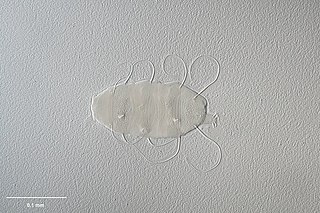 W
WAntechiniscus is a genus of tardigrades in the family Echiniscidae. The genus was first described by Reinhardt Kristensen in 1987.
 W
WThe Echiniscidae are a family of tardigrades, a phylum of water-dwelling, eight-legged, segmented micro-animals. It is one of the four families in the Echiniscoidea order. The family was named by Gustav Thulin in 1928.
 W
WEchiniscoidea are an order of tardigrades, a phylum of water-dwelling, eight-legged, segmented micro-animals. It was first described by Richters in 1926.
 W
WEchiniscus is a genus of tardigrades in the family Echiniscidae. The genus was named and described by Karl August Sigismund Schultze in 1840.
 W
WEutardigrada are a class of tardigrades (Tardigrada) without lateral appendices. Primarily freshwater bound, some species have secondarily gained the ability to live in marine environments (Halobiotus). By cryptobiosis many species are able to live temporarily in very dry environments. More than 700 species have been described.
 W
WThe Hypsibiidae are a family of water bears or moss piglets, tardigrades in the class Eutardigrada.
 W
WHypsibius is a genus of tardigrades in the class Eutardigrada.
 W
WHypsibius dujardini sensu lato is a species complex of tardigrade in the class Eutardigrada. A member of this complex, Hypsibius exemplaris, is widely used for various research projects pertaining to evolutionary biology and astrobiology.
 W
WHypsibius vaskelae is a species of tardigrade in the class Eutardigrada. The species was described from a freshwater sample near Saint Petersburg, Russia. It has wrinkled cuticle and cuticular bars between the bases of its claws on the first four legs. The species most closely resembles Hypsibius marcelli and Hypsibius septulatus, although has a wrinkled dorsal cuticle, thinner claws, and presence of lunules on the claws of all legs.
 W
WThe class Mesotardigrada has only one species, Thermozodium esakii. The animal has six claws of equal length at each foot. This species was recorded in 1937 by Rahm from a hot spring near Nagasaki in Japan. The type location has been destroyed by an earthquake and subsequent searches for specimens have been unsuccessful. The type specimen has also been lost, so the status of this class is considered dubious. However, Grothman et al. (2017) suggests that a type specimen was never collected, in line with lax taxonomic standards of the 1930s. Grothman et al. (2017) also suggests that they might have been misinterpreted heterotardigrades, possibly belonging to either Carphania or Oreella.
 W
WMilnesiidae is a family of tardigrades of the class Eutardigrada.
 W
WMilnesium is a genus of tardigrades. It is rather common, being found in a wide variety of habitats across the world. It has a fossil record extending back to the Cretaceous, the oldest species found so far is known from Turonian stage deposits on the east coast of the United States.
 W
WMilnesium berladnicorum is a species of Eutardigrade in the family Milnesiidae, native to Bârlad, Romania. Brownish in color, the species grows to a length of 400 micrometers. M. berladnicorum was named after the Berladnici, a tribe from Medieval Moldova.
 W
WParachaela is an order of tardigrade in the class Eutardigrada.
 W
WRamazzottius is a genus of water bear or moss piglet, a tardigrade in the class Eutardigrada.
 W
WRichtersius is a monospecific genus of tardigrades in the family Richtersiidae; its sole species is Richtersius coronifer. R. coronifer is one of two species of tardigrade that have been shown to survive and continue reproducing after exposure to outer space, specifically in the thermosphere at 258–281 km above sea level with ionizing solar and galactic cosmic radiation for 10 days. However, unlike Milnesium tardigradum, R. coronifer did not survive under these conditions plus UV exposure.